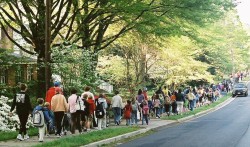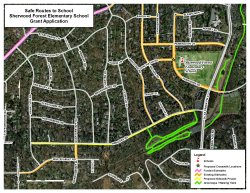Overcoming Opposition to Sidewalk Construction
Winston-Salem, North Carolina
Source: Pedestrian and Bicycle Information Center (PBIC)
Problem
A PTA committee at Sherwood Forest Elementary School in Winston-Salem, N.C., with support from the principal and school staff, worked with city staff on a Safe Routes to School (SRTS) grant application for the school. The proposal included adding almost one mile of new sidewalk along one side of a busy neighborhood street.
Only a week before the grant application was due, some residents on the street heard about the plan for the new sidewalk and mounted a vocal opposition campaign. City Council Member Robert Clark, who represents that ward, stated that he would support construction of the sidewalk only if a clear majority of residents on the street favored the sidewalk. He further added that any resident or property owner who did not respond would be counted as a negative vote. Clark's approval and support was crucial to getting the city council's approval of the grant application and submitting the application to the North Carolina Department of Transportation.

Nearly 200 students and parents participated in this monthly walk to Sherwood Forest Elementary School on a Physical Friday.
Photo: Judi Lawson Wallace
Background
Following a day-long SRTS workshop in September 2006 at Sherwood Forest Elementary School, Sharon S., an energetic and enthusiastic mother who walks her children to school, pulled together a committee of parents to organize monthly walk-to-school events for the students. The goal was to interest more students in walking regularly to school. These events, supported by the principal and school staff, succeeded in attracting 200 students and their parents who walked together from a nearby church. Encouraged by this response, the committee worked with the city staff on an SRTS grant application for the school, which included adding 4,500 feet of new sidewalk along one side of a busy neighborhood street, Kirklees Road.
While the streets immediately around the school have sidewalks, many other streets in the neighborhood do not. Many children would need to use these streets to walk to school, and parents are concerned about their own and their children's safety. Kirklees Road, one of the longest streets in the neighborhood, provides a critical connection for many walkers. Much of this street also borders a city park with a very popular walking trail that many residents enjoy. A sidewalk on Kirklees would not only make it safer for children to walk to school, it would provide a safe connector for residents to walk to the park.
A sidewalk on Kirklees Road would separate pedestrians from motor vehicles on this busy connector, which many people from outside the neighborhood use as a short cut to Silas Creek Parkway. Because of the hilly topography, sight distances are limited; motorists often exceed the 25-mph speed limit. In fact, several pedestrian crashes have occurred in the area, with one adult pedestrian fatality and one serious injury on Kirklees Road in the recent past.

The proposed sidewalk along busy Kirklees Road would connect students' homes with existing sidewalks near Sherwood Forest Elementary School.
Image: City of Winston-Salem
An initial informal survey of homeowners along Kirklees had shown that a majority of those polled favored the sidewalk: 14 said "yes" while nine said "no." However, 11 homeowners either weren't home or didn't respond. Under Council Member Clark's dictum these would count as "no" votes. Once word spread along the street about the proposed sidewalk, neighbors started talking more with each other and those opposed to the sidewalk worked to find more opponents. In some cases, it appeared that the Safe Routes to School grant application was being misrepresented by the sidewalk opponents, which in turn generated great concern among the SRTS committee members.
With only a few days before the crucial city council meeting, the committee had to quickly reach a consensus and act to gain support from the necessary majority of property owners on Kirklees for the sidewalk construction.
Solution
After much e-mail discussion, the committee decided to address the misinformation with a flyer explaining Safe Routes to School and the rationale underlying the grant application. Led by committee member Dixie Y., four representatives of the committee went door-to-door along Kirklees Road. By talking personally — neighbor to neighbor — and handing out the information flyer, this energetic group was able to turn the situation around within 24 hours.
Result
As the result of this personal contact and information-sharing, 54 percent of the property owners agreed to support the sidewalk. The final tally was 20 in favor, 14 opposed, and 3 with no response. Even though those who didn't respond counted as "no" votes, the committee ended up with a majority in favor. At a later Town Hall Meeting, Council Member Clark confirmed publicly that the sidewalk would be constructed if the grant application was funded by the North Carolina Safe Routes to School Program.
The committee followed up with thank-you flyers to those who had voted for the sidewalk and included information about the grant. A separate version of the flyer was created to answer questions that other neighbors might have about the project.
Cost
No costs were incurred because volunteers handled all the work.
Contact
Judi Lawson Wallace
Winston-Salem Coordinator for Safe Routes to School
Wallace Consulting
P.O. Box 15022
Winston-Salem, NC 27113-0022
(336) 768.3339
judiwallace@triad.rr.com
Image sources
Photo: Judi Lawson Wallace
Map: City of Winston-Salem




